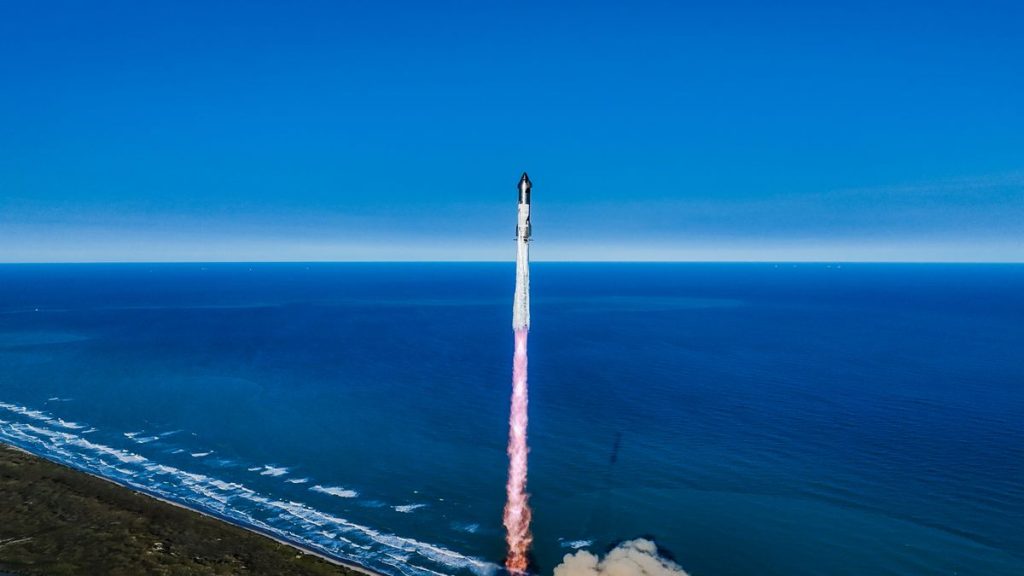The biggest and most powerful rocket ever built now has six test flights under its belt — and it’s just getting started.
SpaceX launched its 400-foot-tall (122-meter-tall) Starship megarocket for the sixth time ever on Tuesday (Nov. 19), sending the giant stainless-steel vehicle skyward from its Starbase site in South Texas.
Starship performed well throughout the lengthy trial. Its Super Heavy first stage splashed down softly in the Gulf of Mexico after an issue with the launch tower precluded a planned “chopsticks” catch-landing back at the pad, and the “Ship” upper stage successful re-lit one of its engines in space and then hit its targeted splashdown zone in the Indian Ocean.
But don’t expect SpaceX to rest on its laurels. Elon Musk‘s company is already looking ahead to Starship Flight 7 — and many more liftoffs after that.
Changes for Flight 7
SpaceX has already conducted some pre-launch checkouts on the seventh Starship vehicle, whose target launch date has not yet been announced. And that spacecraft will be quite different than the one that flew on Tuesday.
Related: Starship and Super Heavy explained
“The Ship has been stretched to make room for larger propellant tanks, increasing the propellant capacity from 1,200 tons to 1,500 tons,” Kate Tice, a senior quality engineering manager at SpaceX, said during the Flight 6 launch webcast. (Flight 6’s Ship spacecraft stood about 165 feet, or 50 meters, tall.)
“The forward flaps also got a redesign,” Tice added. “They have shrunk in size, and they also shifted in location. And both of these things will help better protect them during entry heating while still providing control. There’s also a wide range of upgrades that will make the vehicle more reliable, adding redundancy and the ability to operate for longer durations in space.”
SpaceX has not announced a projected profile for the next Starship mission, but Musk said shortly after Flight 6 that the company will target another ocean splashdown for the Ship upper stage.
“We will do one more ocean landing of the ship. If that goes well, then SpaceX will attempt to catch the ship with the tower,” the billionaire entrepreneur wrote in an X post on Tuesday evening.
Tower catches will eventually become the norm for both Super Heavy and Ship, if all goes according to plan. These precision touchdowns will enable rapid reflight of both stages, a key priority for SpaceX. The company believes that Starship’s combination of power and full reusability will be transformative, allowing humanity to settle the moon and Mars.
Starship flying more and more often
Starship has flown six times to date in its fully stacked configuration — twice in 2023 and four times so far in 2024. But we can expect that rate to balloon in the near future.
SpaceX is apparently targeting 25 Starship launches in 2025, and 100 just a few years after that. And, if all goes to plan, some of those missions will go beyond beyond Earth orbit.
Starship will be the first crewed lander for NASA’s Artemis program of moon exploration, for example, and the current schedule calls for the vehicle to deliver agency astronauts to the lunar south polar region on the Artemis 3 mission in late 2026. The megarocket could also launch toward the Red Planet that same year, according to Musk.
“I am highly confident that we can send several uncrewed Starships to Mars in 2 years. If those ships don’t increment the crater count on Mars, then crewed ships can be sent in 4 years,” he said in an X post on Tuesday night. (Earth and Mars align properly for interplanetary missions every 26 months.)
These bold plans will require a lot of hardware, especially on the Ship side. While each Super Heavy booster will generally come back down to Earth just minutes after launch for inspection and re-flight, the upper stages will stay in space for long stretches, so more of them will be needed.
Indeed, Tice and her Flight 6 webcast co-host, SpaceX manufacturing engineering manager Jessica Anderson, said the company eventually aims to build one Ship every eight hours. This work will be done at Starfactory, the manufacturing facility that SpaceX is constructing at Starbase.
When the Starship assembly line is fully mature, it will be churning out a megarocket that’s even larger and more powerful than the one that lifted off on Tuesday.
“With a few planned upgrades, Starship will have three times the thrust [at liftoff] of Saturn V at 10,000 metric tons of thrust, plus the added benefit of full reusability,” Anderson said during the Flight 6 webcast, referring to NASA’s iconic Saturn V moon rocket, which launched the Apollo missions.
“Starship 2 will be capable of carrying more than 100 tons to orbit, and Starship 3 will be able to lift more than 200 tons to orbit,” she added. “The amount of mass we’re able to launch per rocket is crucial to creating a self-sustaining city on Mars.”

